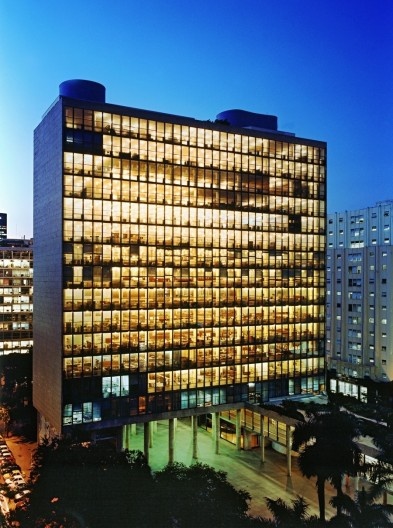
magazines
253.07 Rio de Janeiroyear 22, aug. 2021
abstracts
português
O britânico William Curtis, crítico e historiador de arquitetura, relata a importância da sede do Ministério da Educação e Saúde como obra de arte e como símbolo do Brasil democrático.
english
The British William Curtis, critic and historian of architecture, reports the importance of the headquarters of the Ministry of Education and Health as a piece of art and as a symbol of a democratic society.
how to quote
CURTIS, William J. R.. The destruction of memory. Against the privatisation of a key historical and civic monument. Minha Cidade, São Paulo, year 22, n. 253.07, Vitruvius, aug. 2021 <https://vitruvius.com.br/revistas/read/minhacidade/21.253/8220/en>.

Ministry of Education and Health, Rio de Janeiro RJ Brasil, 1936-1945. Architects Lúcio Costa, Oscar Niemeyer, Affonso Eduardo Reidy, Jorge Moreira, Carlos Leão and Ernani Vasconcellos
Foto/Photo Nelson Kon [SEGRE, Roberto. Ministério da Educação e Saúde. Romano Guerra, 2013]
The Ministry of Education and Health (named the Gustavo Capanema Palace after the Minister of the time), designed in 1936 and completed in 1945 by Lúcio Costa and a team including Oscar Niemeyer and several others (with Le Corbusier as consultant), must be counted as a masterpiece of the Brazilian modern movement in architectural terms: a seminal work expressing the aspirations towards a more equable and just society.
Even though ministerial functions have long since shifted to Brasilia, this work continues to play the role of a national and civic monument marking a progressive epoch in Brazilian history. With its airy public plaza, monumental columns lifting the tower into space, sensuous curves, roof terrace filled with tropical plants, vast glass façades and incisive grilles of brise soleil, the building has a direct impact on the observer and marks out an area of civic importance in the urban landscape of Rio de Janeiro. Visible from afar, even from the sea, the building recalls Le Corbusier's urban visions of the 1930s in which there was the yearning to harmonise industrialisation and the natural world. More than just a building, the Ministry embodies an ethical vision of social improvement, a utopia of a kind.

Getúlio Vargas and Minister Gustavo Capanema (on his left) admire the sculpture “Reclined Woman”, by Celso Antônio, during the inauguration ceremony of the Ministry of Education and Public Health building, Rio de Janeiro, October 3, 1945 [Foto/Photo FGV CPDOC]
This astonishing project showed how the skyscraper as a type normally reserved for private commercial purposes could be modulated to deal with the local climate and to serve a civic, public and symbolic function. Combining the sculptural talents of Costa and Niemeyer, the landscape interventions of Roberto Burle Marx and the public mosaics of Cândido Portinari, the project was conceived as a synthesis of the arts embodying national ideals linked to the abstraction of nature as a key to Brasilian national identity.
The proposed idea of handing over this masterpiece to the short term calculations of private ownership constitutes an ideological assault on civic values and on the history of the nation itself, yet one more attack by this particular regime against the public sphere and progressive values in general whether at the scale of rain forests or that of public national health. Everything must be done to protect this universal masterpiece from an act of vandalism which ignores the values of long term memory in Brazilian society. The Ministry of Education and Health – the Gustavo Capanema Palace – also constitutes a major addition to universal architectural patrimony. and as such deserves protection and preservation in the long term.

Ministry of Education and Health, Rio de Janeiro RJ Brasil, 1936-1945. Architects Lúcio Costa, Oscar Niemeyer, Affonso Eduardo Reidy, Jorge Moreira, Carlos Leão and Ernani Vasconcellos
Foto/Photo Nelson Kon [SEGRE, Roberto. Ministério da Educação e Saúde. Romano Guerra, 2013]
about the author
William J. R. Curtis is a historian and critic of architecture, author of Modern Architecture Since 1900 and Le Corbusier: Ideas and Forms.


